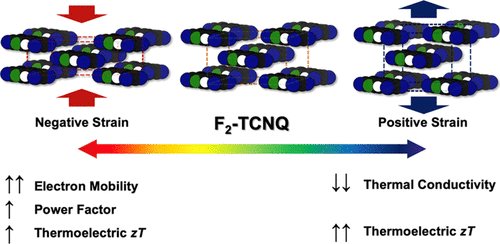当前位置:
X-MOL 学术
›
ACS Appl. Energy Mater.
›
论文详情
Our official English website, www.x-mol.net, welcomes your
feedback! (Note: you will need to create a separate account there.)
Strain Effects on the n-Type Thermoelectric Performance of the Small-Molecule Organic Semiconductor 2-5-Difluoro-7,7,8,8-Tetracyanoquinodimethane
ACS Applied Energy Materials ( IF 5.4 ) Pub Date : 2020-10-14 , DOI: 10.1021/acsaem.0c01875 Zicong Marvin Wong 1 , Tianqi Deng 1 , Wen Shi 1 , Gang Wu 1 , Shuo-Wang Yang 1
ACS Applied Energy Materials ( IF 5.4 ) Pub Date : 2020-10-14 , DOI: 10.1021/acsaem.0c01875 Zicong Marvin Wong 1 , Tianqi Deng 1 , Wen Shi 1 , Gang Wu 1 , Shuo-Wang Yang 1
Affiliation

|
Over the last few years, small-molecule organic semiconductors have been garnering increasing research interest as flexible electronic materials thanks to their abundance, ease of processing, high purity, and low thermal conductivity. In this work, we evaluate in detail the thermoelectric (TE) properties of the small-molecule organic semiconductor 2-5-difluoro-7,7,8,8-tetracyanoquinodimethane (F2-TCNQ) by first-principles calculations and the Boltzmann transport equation. Upon optimal n-doping, a peak power factor of 566 μW m–1 K–2 can be achieved at room temperature, attributed to the band-like three-dimensional (3D) intermolecular electron transport from the efficient overlapping and delocalization of the lowest unoccupied molecular orbitals (LUMOs), which results in high electron mobility and a favorable power factor. Coupled with a low thermal conductivity, this results in an outstanding thermoelectric figure-of-merit zT of 0.46. Furthermore, the zT is predicted to enhance tremendously by up to 120% (0.77) and 50% (0.65) upon application of 5% interlayer tensile and compressive strains, respectively, due to strain interplaying of the power factors and thermal conductivities. These findings not only showcase the potential outstanding TE properties of F2-TCNQ but also indicate strain engineering to be a viable approach toward the enhancement of TE performance, paving the way to methodized screening, identification, and assessment of other analogously layered small organic molecular materials for potentially high-performing TE applications.
中文翻译:

应变对小分子有机半导体2-5-二氟-7,7,8,8-四氰基喹啉二甲烷n型热电性能的影响
在过去的几年中,小分子有机半导体由于其丰富,易于加工,高纯度和低导热性而作为柔性电子材料吸引了越来越多的研究兴趣。在这项工作中,我们通过第一原理计算和玻耳兹曼方法详细评估了小分子有机半导体2-5-二氟-7,7,8,8-四氰基喹二甲烷(F 2 -TCNQ)的热电(TE)特性。运输方程。经过最佳的n掺杂,峰值功率因数为566μWm –1 K –2可以在室温下实现,这归因于最低空位分子轨道(LUMO)的有效重叠和离域,从而实现了带状三维(3D)分子间电子传输,从而实现了高电子迁移率和良好的功率因数。加上低的热导率,这导致出色的热电品质因数zT为0.46。此外,由于功率因数和热导率之间的相互作用,在施加5%的层间拉伸应变和压缩应变后,zT预计将极大地提高120%(0.77)和50%(0.65)。这些发现不仅显示了F 2潜在的潜在TE性能。-TCNQ还表明,应变工程是增强TE性能的可行方法,为可能用于高性能TE应用的其他类似层状小有机分子材料的方法化筛选,鉴定和评估铺平了道路。
更新日期:2020-10-26
中文翻译:

应变对小分子有机半导体2-5-二氟-7,7,8,8-四氰基喹啉二甲烷n型热电性能的影响
在过去的几年中,小分子有机半导体由于其丰富,易于加工,高纯度和低导热性而作为柔性电子材料吸引了越来越多的研究兴趣。在这项工作中,我们通过第一原理计算和玻耳兹曼方法详细评估了小分子有机半导体2-5-二氟-7,7,8,8-四氰基喹二甲烷(F 2 -TCNQ)的热电(TE)特性。运输方程。经过最佳的n掺杂,峰值功率因数为566μWm –1 K –2可以在室温下实现,这归因于最低空位分子轨道(LUMO)的有效重叠和离域,从而实现了带状三维(3D)分子间电子传输,从而实现了高电子迁移率和良好的功率因数。加上低的热导率,这导致出色的热电品质因数zT为0.46。此外,由于功率因数和热导率之间的相互作用,在施加5%的层间拉伸应变和压缩应变后,zT预计将极大地提高120%(0.77)和50%(0.65)。这些发现不仅显示了F 2潜在的潜在TE性能。-TCNQ还表明,应变工程是增强TE性能的可行方法,为可能用于高性能TE应用的其他类似层状小有机分子材料的方法化筛选,鉴定和评估铺平了道路。

































 京公网安备 11010802027423号
京公网安备 11010802027423号